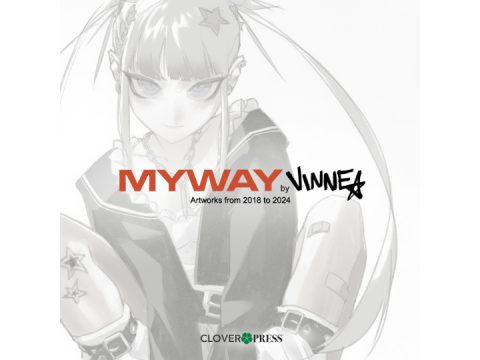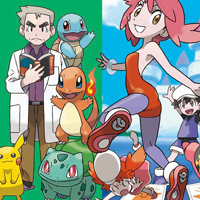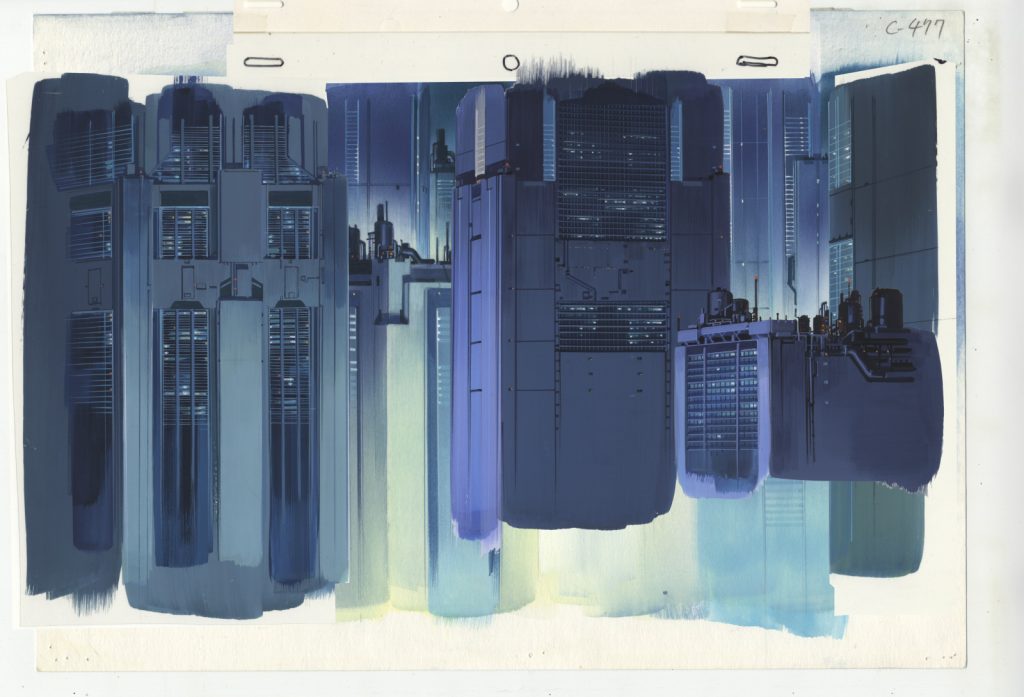
Ghost in the Shell © 1995 Shirow Masamune / KODANSHA •BANDAI VISUAL • MANGA ENTERTAINMENT. All Rights Reserved
Way back in the winter of 2011, I was wandering around Berlin one cold day when I found myself at a pretty incredible exhibition called Proto Anime Cut. The show, organized by curator Stefan Riekeles, featured background paintings, concept art and reference photos from some of my all-time favorite anime films, including Patlabor and Ghost in the Shell. Now those intricate backgrounds are in the foreground in Riekeles’ new art book, Anime Architecture: Imagined Worlds and Endless Megacities. If you’re anything like me, you can stare at this book for hours, appreciating the intricate details put into backgrounds that, in many cases, appear for on-screen for just a few seconds.
Specifically, Anime Architecture features films from the height of when anime backgrounds were done with pencil, paper and paintbrush, like Akira, the Oshii Patlabor films and Ghost in the Shell; and tracks the gradual transition into a hybrid format with computer-enhanced films like Tekkon Kinkreet, Innocence, and the first two Evangelion rebuild films.
I met up with Riekeles over Zoom last week to talk about how the book came together, what inspired him to create it, and what anime megacities mean to us. The following conversation is edited for length and clarity.
Signed copies of Anime Architecture: Imagined Worlds and Endless Megacities are available from the author’s website.
—
Matt
Please tell me about your background and how you got into Japanese animation.
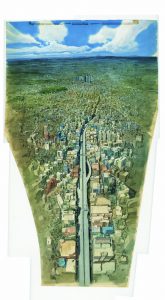
AKIRA: Based on the graphic novel AKIRA by Katsuhiro Otomo. First published by Young Magazine, Kodansha Ltd.
© 1988 MASH • ROOM / AKIRA COMMITTEE All Rights Reserved
Riekeles
My background is in exhibition making. I worked at the Transmediale Festival in Berlin in the exhibition section. In 2005, I had the chance to travel to Japan for a project. I got hooked on the Japan feeling and wanted to go back. After that, a friend of mine, David d’Heilly, hired me as a research assistant to work on an exhibition about anime. That was in 2007.
I had a very privileged start into this whole universe. We went to the studios directly and talked to the creators, and I saw the drawings for the first time. The first things I saw were the background artworks for Ghost in the Shell and Patlabor made by Ogura Hiromasa, the art director.
It was clear to me that these things had to be seen on the wall somewhere in a museum or gallery. Four years later, I was able to realize this first instance of my anime research called Proto Anime Cut, and also the publication Proto Anime Cut Archive.
That was the initial step. We got quite a large amount of drawings out of Japan—well, out of the studios, actually—for the first time, and presented them in Künstlerhaus Bethanien in Berlin, a contemporary art space, who were open to this very unconventional exhibition, in which it wasn’t clear whether it was art, design, or something in between.
This show was quite successful, and it travelled through Europe. The book was also successful. Then in 2016, I approached the Architecture Museum here in Berlin. The idea was to scale down the previous exhibition, add another layer of content and really focus on architecture.
That gave the project more depth and more interesting insights. This show traveled to London. At this point, the first catalog, the Proto Anime Cut Archive book, was sold out. Thames & Hudson came to me and said they wanted to reprint this book or make a new one.
And I thought immediately, “I don’t want to reprint old stuff, I want to make new things.” I also knew what had been missing from the project: the Akira chapter, because that’s the hardest one to get. Actually, I met Otomo (Katsuhiro) in 2008 and proposed this idea to him, but he declined. I met him again in 2010, but he declined again. So in 2018, I proposed it in a personal letter and gave him all kinds of references. Finally, he approved. That’s the long story of how we got to the cover of the book and this great chapter on Akira.
M
And now there’s also a Japanese edition. What has that experience been like?
R
Well, it’s already sold out, or nearly so. So there’s a second print run coming. It’s really successful there.
A lot of the reaction I hear from Japan is usually something like, “oh, why did a German author and British publisher produce such a book? Not a Japanese researcher and a Japanese publisher?”
And the answer is very simple: it’s because of the protective nature of Japanese rights management. I think no really sane Japanese researcher would even try to attempt to compile such a book. It’s very difficult because the assets belong to so many different companies.
Ultimately, it’s more feasible to take it out of Japan and then re-import!
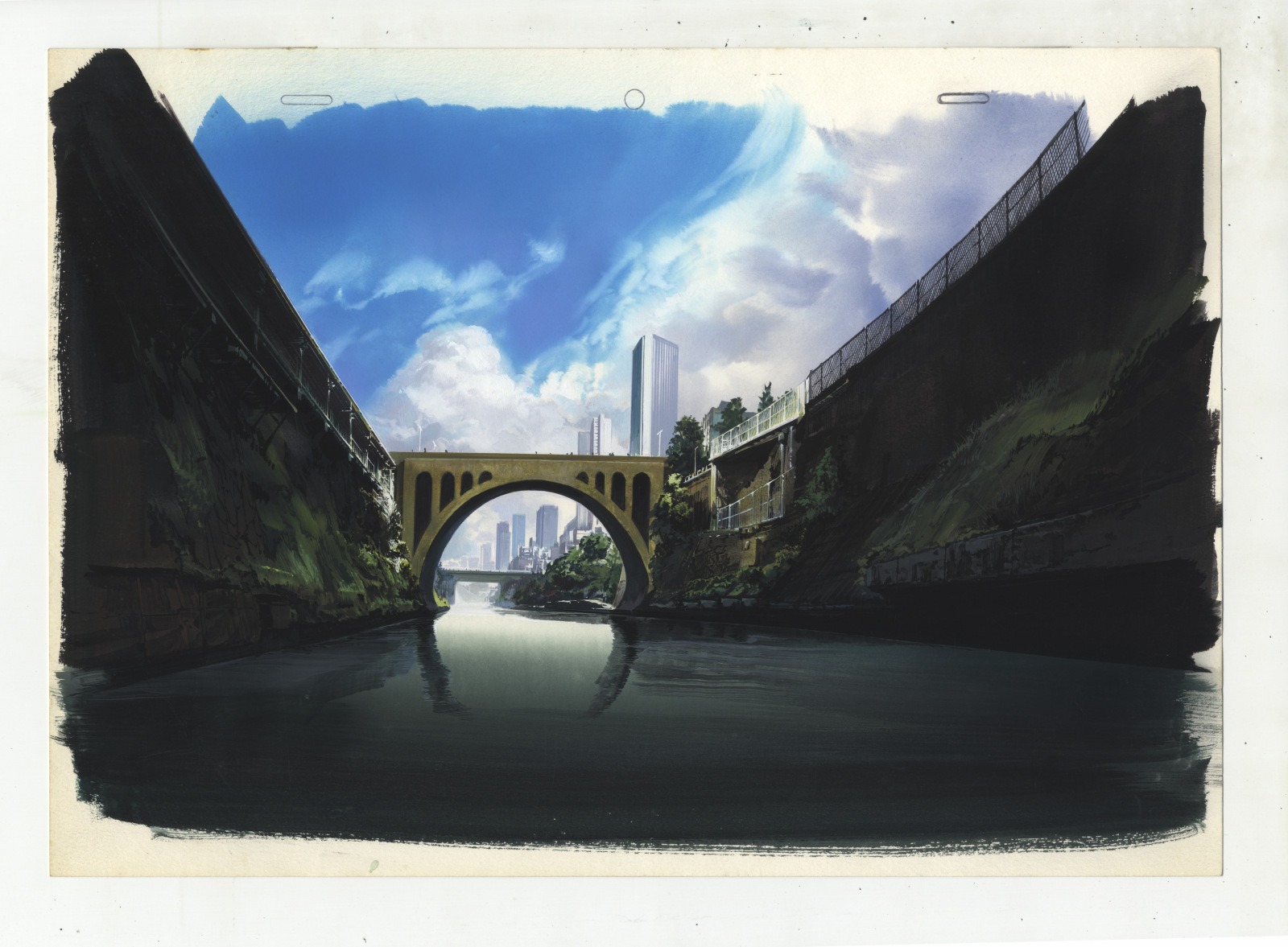
Patlabor: The Movie. © 1989 Headgear
M
In the introduction to the book, you write about your fascination with paint and pencils and paper. Could you talk a little bit about why that appeals to you?
R
Well, in my view, this art form is slowly dying. It’s gradually disappearing. These drawings we have in the book are really the peak of the art form.
In Japanese you say natsukashii. This feeling you get when you see something that’s almost dead or really dead and you remember the liveliness and the beauty of it. That’s at the center of my interest. And these pieces are just outstanding quality. It’s hard to find such mastery.
These artists produce hundreds of pieces for movies. There are very few people who can do this on such a great level. I was simply stunned by these pieces. And as someone who produces exhibitions, I was sure many other people would be, too.
The success of this project is partially because now, artists of the younger generation are trained digitally, and they cannot imagine how to work without deleting your first or last stroke. Control-Z doesn’t exist in that world. When people view the exhibition or the book, sometimes they ask, “what software do they use?” They cannot imagine from today’s perspective that these works were drawn on paper. It’s just another world.
M
Something that struck me reading through the book was how these artists, without digital manipulation, could replicate the way a camera sees the world, replicating a wide angle lens, for example.
R
It’s really crazy. Do they use photographic references of wide angle lenses? Probably. You just take a picture of a cube, and then you have a reference of how the respective lines would be. But when it’s a steady shot, you can simulate it with a still image in the camera, so you can get really close to the cinematic expression.
But when the animation camera starts moving, you cannot simulate this anymore. So that’s really imagination and trial and error. How far can you get in the simulation of this wide angle when the camera is moving? You really have to try and try again, and that takes a long time. It’s just practice. Watabe Takashi and Atsushi Takeuchi are among the masters of this. I think it’s really impressive what they can do with their pencils, simulating focal length.
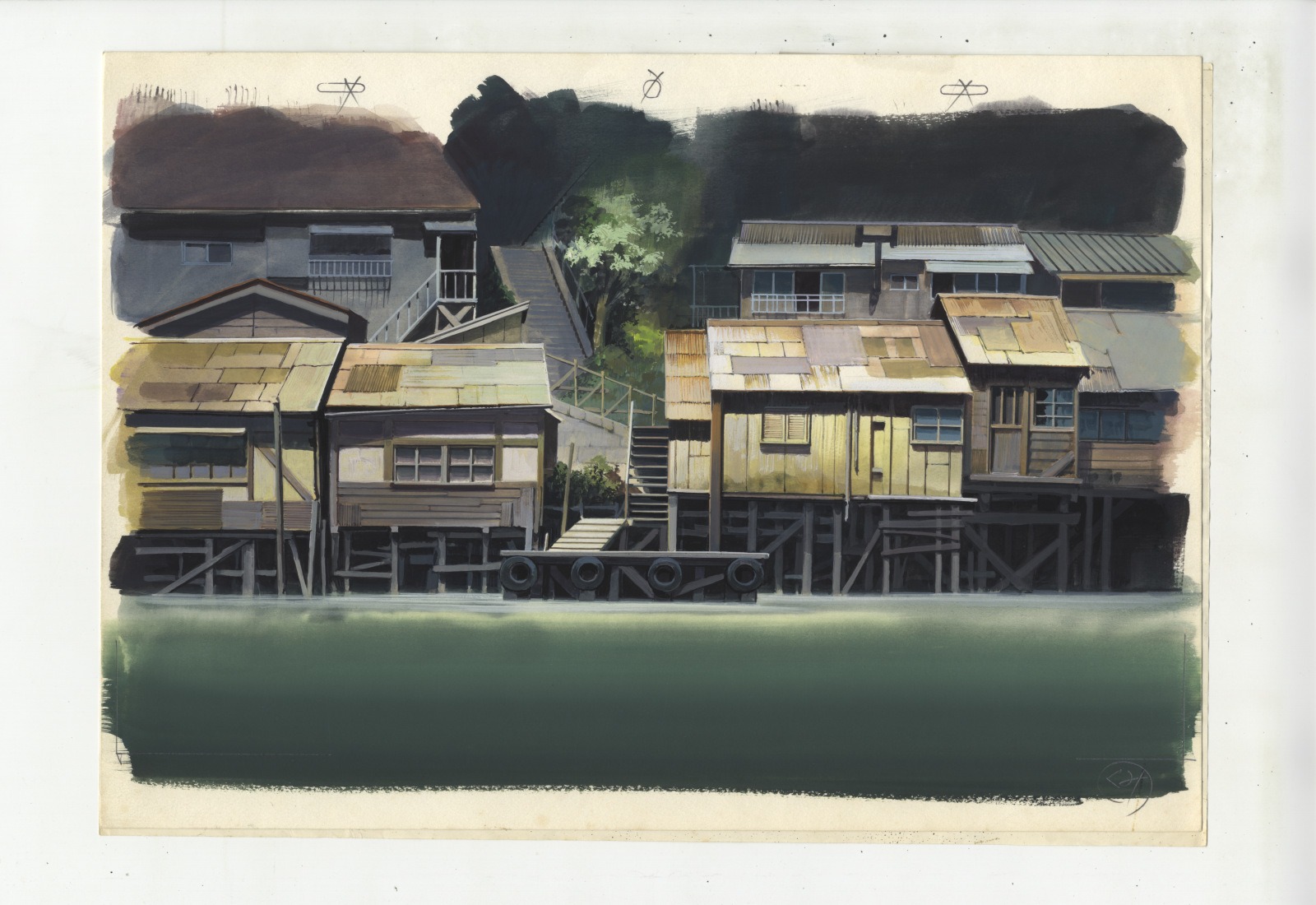
Patlabor: The Movie. © 1989 Headgear
M
When you came to Japan to interview some of these guys, were they surprised that someone was interested in their work to this degree?
R
Yes. They were aware that people were interested in their work, of course. Ogura, for example, had published an art book before. But it was surprising that somebody wanted to show their original pieces on the wall in a museum in Europe. That was surprising because, in the publications you find in Japan, all the images are cropped. You never see the outskirts of the drawing, the dirty parts.
It took me a long time to convince them that this is exactly what we want to see, because it proves this intermediary status of these materials as drawings made for film, and as beautiful artifacts which could be appreciated in the museum. That was difficult. It helped that I came from Berlin, from far away, and that I insisted for a long time that we have to take the originals and not prints.
It took a lot of effort. But now all the people we gradually convinced support the project.
M
How did you choose which titles to include in this book?
R
The whole thing is an extension, of refocus, of the Proto Anime Cut project. It was clear that the focus is science fiction, the 80s to 90s, the peak of this craft. That was when the most detailed backgrounds were drawn on paper. We wanted to have this and focus on the art directors. The Akira fight took a lot of energy, but it really needs Akira if it’s going to be the book on science fiction anime of the 80s and 90s.
I also added the pieces from the early 2000s, because I felt that it was necessary to show how this artform is slowly disappearing, how the drawings become empty, with more void spaces, and how they are used as textures in 3D modeling.
I understand now that we achieved something really interesting because of the reaction of the readers. I think the largest part of the audience of this book are concept artists and designers, people working in the industry. I’m very happy that I can feed their inspiration.
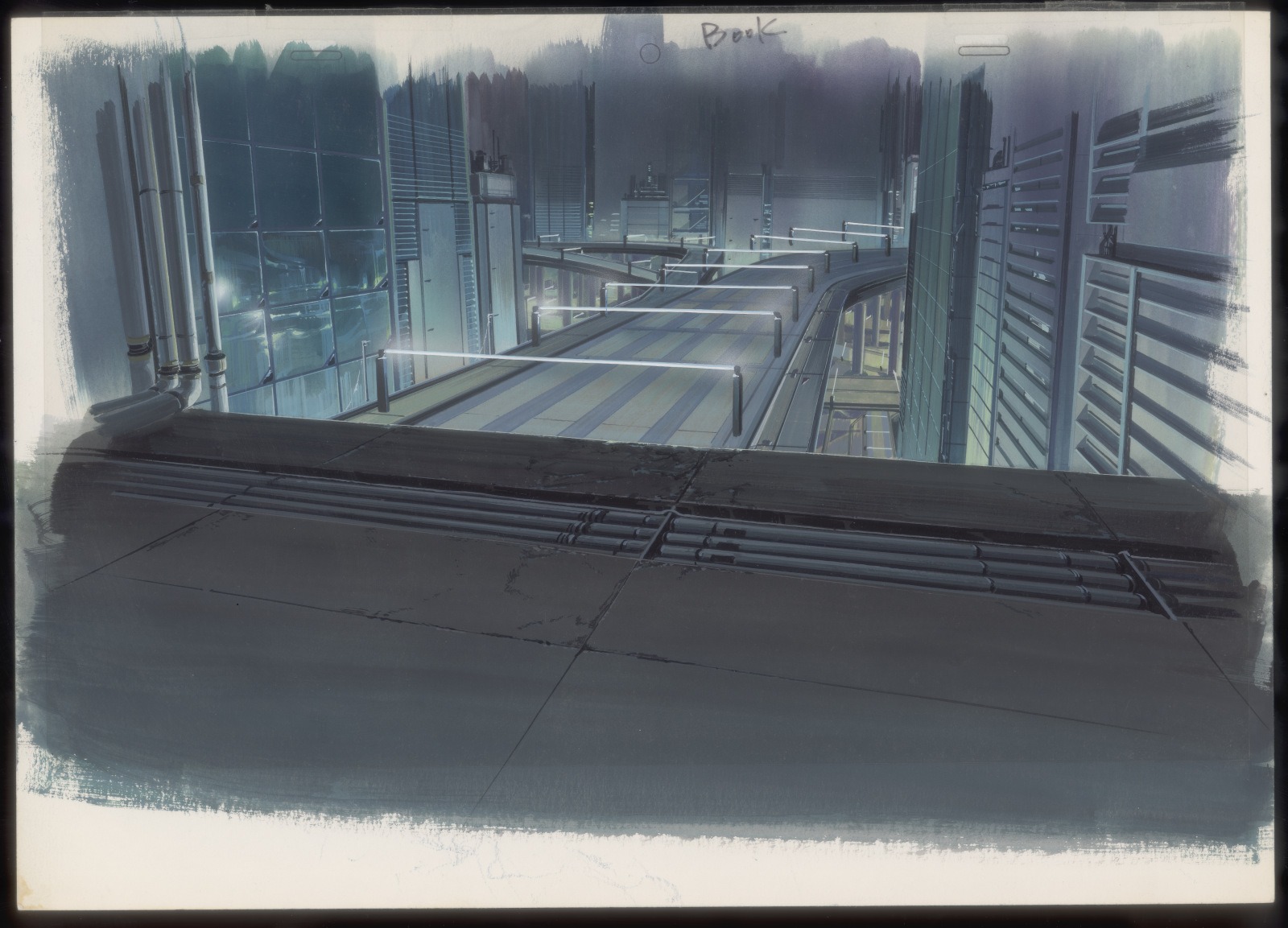
Ghost in the Shell © 1995 Shirow Masamune / KODANSHA •BANDAI VISUAL • MANGA ENTERTAINMENT. All Rights Reserved
M
These backgrounds are meant to be seen on film, or on a screen, and are often partially covered up by cels. Were they any surprises when you looked at them close up, rather than in a theater on a screen?
R
You’ve just reminded me of another very important selection criteria for the book. All these anime are feature films. In these films, you have more budget for the artwork because you need to fill the big screen. You need more details. And therefore, these drawings are much more detailed than TV series.
Now, what happened during the production of this book is that many of the movies, like Ghost in the Shell and Akira, got a 4K rerelease or remastering. In this very high definition video, you can see sometimes even more detail in the background than you can see in this book, because the resolution is higher on screen. That’s a really strange situation, because print had always been the highest resolution!
But the beauty of these backgrounds, in the book or in the museum, is that you can study them for a long time, which gives you a much deeper understanding. On the screen, you can stop, but you never see it in total when the camera is moving. And you cannot appreciate or understand how it’s been made into this illusion of a moving camera. You only understand how the movie was made when you see the whole thing.
M
You’ve got this collection of films that a lot of science fiction fans love, and on the surface, they seem to look very similar. But actually, when you dig into them, they all have quite a lot of differences. Were you struck by any of those differences?
R
Right, when you look at them superficially, it’s a coherent look. It all looks like anime. Then you have all these differences, but also coherence, when you look at the careers of the art directors, especially Ogura, whose career is very prominent in this book, from Patlabor to Akira. He worked on almost all the productions in here.
You can see how the style of Ogura and others developed over time: how it evolved along with digital tools. They’re especially important when it comes to the works of Kusamori. He started purely with line drawings and then slowly moved into the digital realm, then began integrating everything. I found it really compelling to trace the artistic evolution of these artists.
Now we have this book, an overall thematic focus, but it would be really good to have books on each art director.

Patlabor 2 location scouting photo by Haruhiko Higami
M
One of my favorite parts of the book is the location photos from Haruhiko Higami. Could you talk a bit about his still photography?
R
Yes, it’s fascinating to see the black and white photography. And the idea that he was ordered to take black and white photographs in order not to influence the film’s color palette. To me, he’s a very special person, because he used to be almost the right hand to Oshii in creating these sets. He was the camera eye of Oshii. Because Oshii is, among all these directors in the book, the most cinematic one. He’s the one who really pushes the idea of the camera lens and the layout work to extremes.
It’s probably impossible to figure out whether Oshii or Higami decided, aesthetically, which angles to photograph and how. I think they very close because on all the location trips, they were together. Apart from the location photographs, Higami also took a lot of documentation.
For Patlabor, they went gun shooting. How does it work to shoot a rifle, really? How does it move? How do you move when you shoot? So they studied many, many things.
—
Signed copies of Anime Architecture: Imagined Worlds and Endless Megacities are available from the author’s website.


